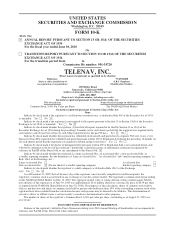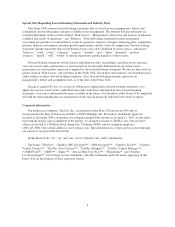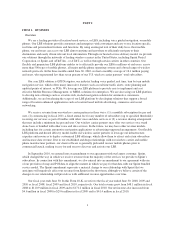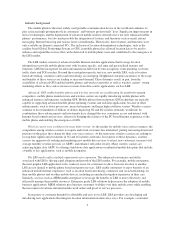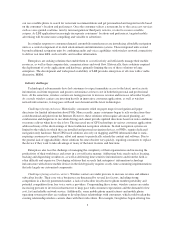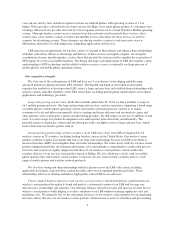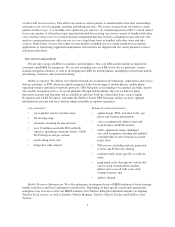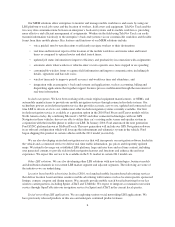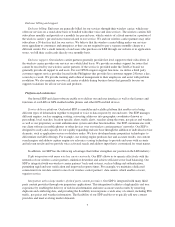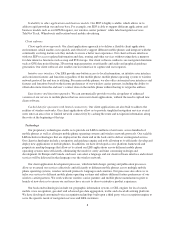TeleNav 2010 Annual Report Download - page 5
Download and view the complete annual report
Please find page 5 of the 2010 TeleNav annual report below. You can navigate through the pages in the report by either clicking on the pages listed below, or by using the keyword search tool below to find specific information within the annual report.Industry background
The mobile phone is the most widely used portable communication device in the world and continues to
play an increasingly prominent role in consumers’ and business professionals’ lives. Significant improvements in
device technologies and the deployment of advanced mobile wireless networks have not only enhanced mobile
phones’ performance, but also made possible the integration of features and functions such as email, instant
messaging, Internet browsing and various forms of multimedia. Historically, these features and functions were
only available on Internet connected PCs. The inclusion of location determination technologies, such as the
satellite based Global Positioning System, or GPS, in mobile phones has allowed location data to be used to
enhance and expand the services that can be delivered to mobile phone users and contributed to the emergence of
the LBS market.
The LBS market consists of advanced mobile Internet and data applications that leverage location
information to provide mobile phone users with location specific, real time and personalized features and
functions. LBS that incorporate location information include turn by turn navigation, route planning, real time
traffic alerts and POI searches. Beyond these navigation specific services, new mobile LBS, such as location
based advertising, commerce and social networking, are emerging. Heightened consumer awareness of the scope
and benefits of these services are leading to increased demand. These dynamics result, in part, from the
availability of advanced GPS enabled mobile phones and wireless networks as well as wireless carriers’ strong
marketing efforts as they seek to increase revenue from data-centric applications, such as LBS.
Advanced, GPS enabled mobile phones and wireless networks are proliferating. In an effort to remain
competitive, mobile phone manufacturers and wireless carriers are rapidly introducing mobile phones with
enhanced features and functions, including GPS. Mobile phones that incorporate GPS technology are typically
capable of supporting advanced mobile phone operating systems and rich data applications because of other
enhancements, such as faster processors, increased memory and larger high resolution screens. Wireless carriers
continue to invest hundreds of billions of dollars deploying 3G and 4G wireless networks worldwide. In
combination, these advancements and investments have changed the way consumers access and interact with
Internet based content and services, effectively bringing the richness of the PC based Internet experience to the
mobile phone and enabling the emergence of LBS.
Wireless carriers are seeking to increase data revenue. As the market for mobile voice services matures, the
competition among wireless carriers to acquire and retain customers has intensified, putting increasing downward
pressure on the prices they charge for their core voice services. At the same time, wireless carriers are seeking to
recoup their significant investments in 3G and 4G wireless networks. In response to these dynamics, wireless
carriers are aggressively seeking and marketing new mobile data services to attract new customers, increase total
average monthly revenue per user, or ARPU, and enhance subscriber loyalty. Many wireless carriers are
achieving higher data ARPU by offering stand alone data applications or unlimited mobile data plans that include
a bundle of key applications, such as mobile navigation.
The LBS market offers multiple opportunities for expansion. The enhanced convenience and utility
associated with LBS is driving rapid adoption and growth of the LBS market. For example, mobile navigation,
the most popular LBS application today, makes it easier for consumers to drive from one location to another.
LBS are not limited to mobile phone based navigation services. LBS enable consumers to enjoy benefits of an
enhanced mobile Internet experience, such as location based advertising, commerce and social networking, on
their mobile phones and on other mobile devices, including an enriched navigation experience in their cars.
Similarly, services such as MRM enable enterprises to leverage the benefits of LBS to more effectively and
efficiently manage their mobile resources. Enterprise grade LBS solutions help increase the adoption of mobile
business applications. MRM solutions give business customers visibility over their mobile assets while enabling
the movement of real time information like work orders and proof of service processes.
In response to consumer demand for affordable and easy to use LBS, LBS providers are developing and
introducing new applications that integrate location information in innovative ways. For example, a consumer
2

